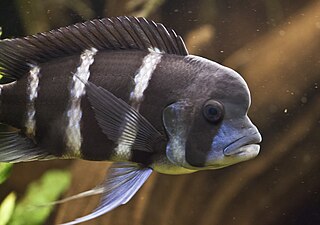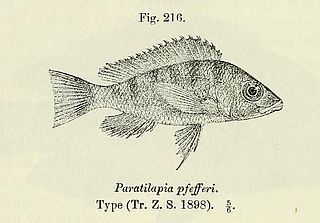
Lake Tanganyika is an African Great Lake. It is the second-oldest freshwater lake in the world, the second-largest by volume, and the second-deepest, in all cases after Lake Baikal in Siberia. It is the world's longest freshwater lake. The lake is shared between four countries—Tanzania, the Democratic Republic of the Congo (DRC), Burundi, and Zambia, with Tanzania (46%) and DRC (40%) possessing the majority of the lake. It drains into the Congo River system and ultimately into the Atlantic Ocean.

Cyphotilapia frontosa, also called the front cichlid and frontosa, is an east African species of fish endemic to Lake Tanganyika. The genus name is a combination of the Ancient Greek "cypho-", meaning "curved", and tilapia, which means "fish" in a local dialect. The species name frontosa is a reference to its relatively large forehead.

Gnathochromis is a small genus of cichlid fish endemic to the Lake Tanganyika basin in East Africa.

Reganochromis calliurus is a species of cichlid endemic to Lake Tanganyika in East Africa. It lives over a sandy substrate in deeper coastal waters, to depths of at least 60 m (200 ft). Its preferred diet consists mostly of shrimp. It can reach a total length of 15 cm (5.9 in). This fish can also be found in the aquarium trade. It is currently the only known member of its genus.
Chelaethiops minutus is a species of ray-finned fish in the family Cyprinidae. It is endemic to Lake Tanganyika and its outflow, the Lukuga River and is found in Burundi, Democratic Republic of the Congo, Tanzania, and Zambia.
Benthochromis melanoides is a species of fish in the family Cichlidae. It is endemic to the deep waters of Lake Tanganyika, where it lives in deep water and feeds on plankton and crustaceans.

Gnathochromis pfefferi is an African species of fish in the family Cichlidae. It is endemic to Lake Tanganyika and its slow-flowing tributaries in the countries of Burundi, the Democratic Republic of the Congo, Tanzania and Zambia. It is common and widespread. This cichlid is found in relatively shallow waters, typically over soft bottoms in places with aquatic grasses.

Julidochromis marlieri is a species of cichlid endemic to Lake Tanganyika where it is only known from the northwestern portion preferring rocky shorelines in deep waters. In the aquarium trade, it is commonly known as Marlier's Julie, Spotted Julie or Chequered Julie. This species reaches a length of 15 centimetres (5.9 in) TL. Adult females are larger than adult males. The specific name honours the Belgian zoologist Georges Marlier who collected the type.
Lamprologus signatus is a species of cichlid endemic to Lake Tanganyika where it prefers deep waters over muddy substrates. This species is a shell dweller. This species can reach a length of 5.5 centimetres (2.2 in) TL. It can also be found in the aquarium trade.
The bigeye lates is a species of lates perch native to Lake Tanganyika and from the Lualaba drainage in the Democratic Republic of the Congo. Juveniles inhabit inshore habitats while adults inhabit benthic environments in deeper waters, being the top predator at depths of 100 metres (330 ft) and greater. It is known to make diurnal migrations to surface waters to prey on pelagic fishes. This species can reach a length of 80 centimetres (31 in) TL. This species is commercially important and is also popular as a game fish.
Limnochromis abeelei is a species of cichlid endemic to Lake Tanganyika where it occurs in deeper waters in the southern portion of the lake. This species can reach a length of 23.5 centimetres (9.3 in) TL. Some authorities place this species in the genus Greenwoodochromis. The specific name honours the Belgian colonial administrator M.M. van den Abeele who supported the Belgian Hydrobiological Mission to Lake Tanganyika (1946-1947), on which type was collected.

The spangled cichlid is a species of cichlid endemic to Lake Tanganyika where it is found in deep waters. This species can reach a length of 13 centimetres (5.1 in) TL. It can also be found in the aquarium trade.

The Lake Tanganyika sardine is a species of freshwater fish in the family Clupeidae which was endemic to Lake Tanganyika but which has now been introduced to other lakes in Africa as a food source. It is monotypic within the genus Limnothrissa. It and the Lake Tanganyika sprat are known collectively as kapenta.

Limnotilapia dardennii, the latticed cichlid, is a species of cichlid endemic to Lake Tanganyika, where it prefers rocky areas near the coast. It may also be found in the aquarium trade. This species is currently the only known member of its genus.

Simochromis diagramma is a species of cichlid endemic to Lake Tanganyika where it prefers murky waters with rock-rubble substrates usually at less than 5 metres (16 ft) and never deeper than 10 metres (33 ft). It can reach a length of 19.5 centimetres (7.7 in) TL. It can also be found in the aquarium trade.
Pseudosimochromis margaretae is a species of cichlid endemic to Lake Tanganyika where it is only known from the area of Kigoma in Tanzania. It prefers waters with rock-rubble substrates, mostly at less than 5 metres (16 ft) but not deeper than 10 metres (33 ft). It can reach a length of 8.1 centimetres (3.2 in) SL. It can also be found in the aquarium trade. The specific name honours Margaret Mary Smith (1916-1987), who was the first director of the J.L.B. Smith Institute of Ichthyology.
Pseudosimochromis marginatus is a species of cichlid endemic to Lake Tanganyika in East Africa. It prefers shallow waters with rock rubble substrates. It can reach a length of 10 centimetres (3.9 in) TL. It can also be found in the aquarium trade.
Tangachromis dhanisi is a species of cichlid endemic to Lake Tanganyika where they live in deep waters having been caught at depths of 100 metres (330 ft). They prey on copepods. This species reaches a length of 8.5 centimetres (3.3 in) TL. They can also be found in the aquarium trade.

Xenochromis hecqui is a species of cichlid endemic to Lake Tanganyika in East Africa. It is mainly found at depths of 6–100 m (20–328 ft), but has been recorded somewhat deeper, even in waters virtually devoid of oxygen. This species is a scale eater, consuming the scales off of other fishes, but will also feed on copepods. It can reach a total length of up to 30 cm (12 in). Currently it is the only known member of its genus. The specific name honours the Belgian Lieutenant Célestin Hecq (1859-1910), a member of the Belgian colonial forces fighting the slave trade who collected the type of this species.

Mastacembelus ellipsifer is a species of spiny eel that is endemic to Lake Tanganyika in Africa and sometimes kept in aquariums. Although sometimes called the Tanganyikan spiny eel, it is only one of fifteen spiny eel species in the Tanganyikan basin.













